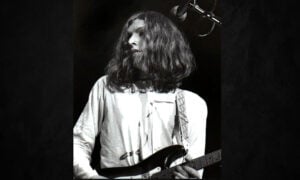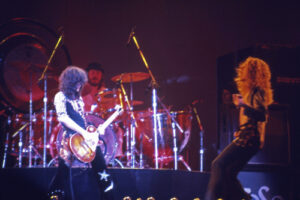
Feature Photo: Dina Regine, CC BY-SA 2.0 <https://creativecommons.org/licenses/by-sa/2.0>, via Wikimedia Commons
Ask any classic rock fan to put together a list of their favorite bands, and you will find Traffic on that list. Traffic was formed in Birmingham in 1967 by Steve Winwood, Jim Capaldi, Chris Wood, and Dave Mason. Fans loved the way the group blended elements of rock, jazz, and psychedelia into their sound. Traffic’s innovative approach to music and their ability to craft songs seamlessly integrated various musical styles, setting them apart from their contemporaries.
Traffic released their first single, “Paper Sun,” in 1967, which was closely followed by their debut album, Mr. Fantasy, later the same year. Over the years, Traffic released a total of eleven studio albums, including Traffic (1968), John Barleycorn Must Die (1970), and The Low Spark of High Heeled Boys (1971), among others. Their discography also includes several live albums, compilations, and EPs, contributing to a rich and diverse musical legacy.
The band’s sound was heavily influenced by artists such as The Beatles, Bob Dylan, and the jazz and blues genres, which is evident in their eclectic musical style. In turn, Traffic has inspired a wide range of musicians and bands across various genres, from classic rock acts to contemporary artists exploring progressive and psychedelic sounds.
Traffic’s contributions to music were recognized with their induction into the Rock and Roll Hall of Fame in 2004, a testament to their lasting impact on the music world. Their ability to experiment with different musical forms and their success in creating timeless, genre-defying tracks have cemented their status as pioneers in the industry.
Shoot Out at the Fantasy Factory
Released 1973
Shoot Out at the Fantasy Factory, Traffic’s sixth studio album released in 1973, serves as a follow-up to their acclaimed 1971 album The Low Spark of High Heeled Boys. This album, while not as critically celebrated as its predecessor, still managed to make a significant impact by reaching number six on the Billboard Pop Albums chart, surpassing Low Spark‘s peak position. Notably, the original LP jacket of Shoot Out continued the design trend of its predecessor by having its top right and bottom left corners clipped, adding a unique physical characteristic to its presentation. The album was given a new life with a remastering in 2003, enhancing its audio quality for contemporary audiences.
Recording for Shoot Out featured a collaboration with four members of the esteemed Muscle Shoals Rhythm Section, including bassist David Hood and drummer Roger Hawkins, who played on all the tracks and were credited as Traffic members on the album sleeve. Keyboardist Barry Beckett and guitarist Jimmy Johnson also contributed, specifically on the track “Tragic Magic”. This integration of Muscle Shoals talent not only brought a fresh dynamic to the album’s sound but also saw Hood, Hawkins, and Beckett joining Traffic for subsequent tours, as reflected in the live album On the Road.
The track listing of Shoot Out at the Fantasy Factory is concise with five songs, all penned by Steve Winwood and Jim Capaldi, except for “Tragic Magic” by Chris Wood. The album’s side one kicks off with the title track and is followed by the epic “Roll Right Stones”. Side two features “Evening Blue”, “Tragic Magic”, and “(Sometimes I Feel So) Uninspired”, culminating in a total length of 39:18 minutes.
An interesting note about the album versions is the initial exclusive availability of the full-length master on the U.S. vinyl version distributed by Capitol Records. Subsequent versions, after the end of Island’s distribution deal with Capitol, featured remixed and shortened versions of “Roll Right Stones” and “Uninspired” until the 2003 remaster restored these tracks to their original lengths on CD.
Personnel on the album included core members Steve Winwood, Chris Wood, along with David Hood, Roger Hawkins, and Jim Capaldi, with additional contributions from Barry Beckett and Jimmy Johnson on “Tragic Magic”. The production was led by Winwood and Capaldi, with Jerry Masters and Steve Melton engineering, and the album’s visual aspects were crafted by Tony Wright (cover illustrations) and Tommy Wright (photography).
Despite its mixed critical reception, Shoot Out at the Fantasy Factory achieved commercial success, evidenced by its gold certification in March 1973, and it remains a notable entry in Traffic’s discography, capturing a period of experimentation and transition for the band.
CD Track Listings:
- “Shoot Out at the Fantasy Factory” – 6:05
- “Roll Right Stones” – 13:40
- “Evening Blue” – 5:19
- “Tragic Magic” – 6:39
- “(Sometimes I Feel So) Uninspired” – 7:31
When the Eagle Flies
Released 1974
When the Eagle Flies, Traffic’s seventh studio album released in 1974, marked the end of an era for the band, being their last studio effort before a two-decade hiatus. This album saw the collaboration of Jim Capaldi, Steve Winwood, Chris Wood, and the addition of Rosko Gee on bass guitar. Notably, percussionist Rebop Kwaku Baah contributed to two tracks before his departure from the band during the album’s production. Winwood expanded the band’s sound on this album by incorporating a wider range of keyboard instruments, including the Moog synthesizer, enriching Traffic’s already diverse musical palette.
The album continued Traffic’s success in the United States, becoming their fourth consecutive studio album to reach the Top Ten and achieve gold status. However, its reception in the UK was lukewarm, with the album briefly entering the charts before quickly disappearing. Despite this discrepancy in reception, When the Eagle Flies showcased the band’s continued evolution and experimentation with sound.
The album was supported by a tour, but Traffic disbanded midway through, marking a premature end to their activities until Winwood and Capaldi’s reunion in 1994 for Far from Home. An interesting note is the exclusion of Chris Wood’s composition “Moonchild Vulcan” from the album, which was instead replaced by “Memories of a Rock n’ Rolla”. Although “Moonchild Vulcan” was performed during the album’s supporting tour, it would not be officially released until 2008 on the posthumous Chris Wood CD Vulcan.
The track listing of When the Eagle Flies is a blend of Winwood and Capaldi’s collaborative writing, with the exception of “Dream Gerrard”, which was co-written with Vivian Stanshall. The album unfolds with “Something New” and ventures through a diverse soundscape including the epic “Dream Gerrard” and the introspective title track “When the Eagle Flies”.
Personnel on the album included Winwood’s dynamic vocals and instrumental skills, Chris Wood’s wind instruments, Gee’s bass contributions, and Capaldi’s work on drums, percussion, and backing vocals. The production, led by Chris Blackwell, with engineering by Nobby Clark and Brian Humphries, captured the essence of Traffic’s sound during this period.
Despite its mixed critical reception, When the Eagle Flies stands as a significant chapter in Traffic’s discography, reflecting the band’s ability to explore new sonic territories while maintaining their distinctive identity. The album’s legacy is a testament to Traffic’s influence in the rock genre and their willingness to experiment and evolve, even at the twilight of their initial run.
CD Track Listings:
- “Something New” – 3:15
- “Dream Gerrard” – 11:03
- “Graveyard People” – 6:05
- “Walking in the Wind” – 6:48
- “Memories of a Rock N’ Rolla” – 4:50
- “Love” – 3:20
- “When the Eagle Flies” – 4:24
Far from Home
Released 1994
Far from Home, the eighth and final studio album by the iconic rock band Traffic, emerged as a poignant revival of the band’s creative spirit after a 20-year hiatus. Released on 9 May 1994, this album not only rekindled the collaborative songwriting fire between Steve Winwood and Jim Capaldi but also marked the first Traffic project since their last album in 1974. Recorded in the serene setting of Woodstock near Dublin, Ireland, and mixed at the picturesque Chateau Miraval in southern France, Far from Home carries the essence of Traffic’s earlier works while embracing a modern sound.
The album features Winwood’s multi-instrumental talents prominently, with him playing all instruments and performing all vocals, except for Capaldi’s contributions on drums and backing vocals. The addition of Davy Spillane’s Uilleann pipes on “Holy Ground” and Mick Dolan’s rhythm guitar and programming on “Nowhere Is Their Freedom” further enrich the album’s texture. Notably, the track “State of Grace” was initially intended for a Capaldi solo project but found its home in this Traffic album, adding a layer of depth to the duo’s collaborative resurgence.
Upon its release, Far from Home achieved significant commercial success, especially in the UK, where it reached number 29 on the Albums Chart, marking Traffic’s most successful album in their home country since John Barleycorn Must Die. The album also resonated with audiences in Germany, charting at number 22, and in the USA, where it climbed to number 33 on the Billboard chart, showcasing Traffic’s enduring appeal across different markets.
The album’s artwork, featuring a 3D-rendered stick figure playing a flute against a checkerboard floor and a dark blue-gradient background, encapsulates Traffic’s signature blend of simplicity and complexity. This visual theme is carried through the CD’s packaging, which includes blurry photographs of Winwood and Capaldi, adding a nostalgic touch to the album’s presentation.
Tracklist highlights include the expansive “Far from Home”, the rhythmic “Here Comes a Man”, and the introspective “State of Grace”, among others, all co-written by Winwood and Capaldi, with the exception of “Holy Ground”, a collaborative effort with Spillane.
The personnel on Far from Home underscores the collaborative nature of the project, with Winwood and Capaldi steering the ship, supported by Dolan and Spillane. The album’s production and technical team, including engineer and mixer Mick Dolan and mastering expert Tim Young, played crucial roles in bringing Traffic’s vision to life.
Far from Home stands as a testament to Traffic’s legacy, bridging the gap between their rich past and the contemporary music scene of the 1990s.
CD Track Listings:
- “Riding High” – 5:18
- “Here Comes a Man” – 5:10
- “Far from Home” – 8:38
- “Nowhere Is Their Freedom” – 7:00
- “Holy Ground” – 7:49
- “Some Kinda Woman” – 5:42
- “Every Night, Every Day” – 5:41
- “This Train Won’t Stop” – 5:58
- “State of Grace” – 7:18
- “Mozambique” – 4:26
TRAFFIC LIVE ALBUMS
Welcome To The Canteen
Released September 1971
Welcome to the Canteen is a live album by the English rock band Traffic, released in September 1971. This album is somewhat unique in the band’s discography for several reasons. Notably, it was not originally credited solely to Traffic, but rather to the individual members Steve Winwood, Jim Capaldi, Chris Wood, Dave Mason, Ric Grech, Jim Gordon, and Reebop Kwaku Baah, reflecting the fluid and collaborative nature of the band’s lineup during this period. However, subsequent reissues have typically attributed the album to Traffic.
Recorded live from performances at Fairfield Halls, Croydon, and the Oz Benefit Concert at the Fillmore East in New York City, Welcome to the Canteen captures the band in a transitional phase, showcasing their improvisational skills and the chemistry between the ensemble members. The album features a mix of Traffic songs, Dave Mason’s solo work, and a Spencer Davis Group classic.
Track Listing:
- “Medicated Goo” (Steve Winwood, Jimmy Miller) – A high-energy performance of the Traffic staple, showcasing the band’s tight groove and Winwood’s powerful vocals.
- “Sad and Deep as You” (Dave Mason) – A reflective and soulful rendition of Mason’s solo work, highlighting his poignant songwriting and expressive guitar playing.
- “40,000 Headmen” (Winwood, Jim Capaldi) – A Traffic fan favorite, delivered with the band’s signature blend of rock and psychedelia.
- “Shouldn’t Have Took More Than You Gave” (Mason) – Another track from Mason’s solo repertoire, featuring extended jams and dynamic interplay between the musicians.
- “Dear Mr. Fantasy” (Winwood, Capaldi, Chris Wood) – A compelling live version of one of Traffic’s most beloved songs.
- “Gimme Some Lovin'” (Spencer Davis, Winwood, Muff Winwood) – A high-octane cover of the Spencer Davis Group hit, driven by Winwood’s energetic vocals and keyboard work, closing the album on a rousing note.
Personnel:
- Steve Winwood: Vocals, guitar, piano.
- Jim Capaldi: Drums, vocals
- Chris Wood: Saxophone, flute
- Dave Mason: Guitar, vocals
- Ric Grech: Bass
- Jim Gordon: Drums
- Reebop Kwaku Baah: Percussion
On The Road
Released October 1973
On the Road is a live album by the English rock band Traffic, released in October 1973. This album captures the band during their 1973 tour, following the release of their critically acclaimed studio album Shoot Out at the Fantasy Factory. On the Road is notable for its extended jam sessions and the inclusion of new members who contributed to the rich, live sound that Traffic was known for during this period.
Track Listing:
- “Glad” / “Freedom Rider” – This medley opens the album with a dynamic blend of two songs from the John Barleycorn Must Die album.
- “Tragic Magic” (Chris Wood) – Written by saxophonist Chris Wood, this track features extended solos and a jazz-oriented approach, highlighting Wood’s compositional skills and the band’s ability to explore beyond the boundaries of rock.
- “(Sometimes I Feel So) Uninspired” – A deep, reflective piece that allows Steve Winwood’s emotive vocals and keyboard work to shine, supported by the band’s tight, empathetic backing.
- “Shoot Out at the Fantasy Factory” – The title track from their preceding studio album, this live version brings new energy to the song, with extended instrumental sections that give each band member a moment in the spotlight.
- “Light Up or Leave Me Alone” (Jim Capaldi) – This track, penned by drummer Jim Capaldi, features a catchy riff and groove, providing a platform for spirited solos and improvisations.
- “The Low Spark of High Heeled Boys” – An epic rendition of one of Traffic’s most iconic tracks, this version stretches out with expansive solos and a mesmerizing groove, encapsulating the essence of Traffic’s live sound.
Personnel:
- Steve Winwood: Vocals, guitar, keyboards – Winwood’s multifaceted talents anchor the album, with his soulful voice and virtuosic playing leading the charge.
- Jim Capaldi: Drums, percussion, backing vocals – Capaldi not only provides the rhythmic foundation but also contributes vocally, adding depth to the band’s live arrangements.
- Chris Wood: Saxophone, flute – Wood’s wind instruments add color and texture, with his solos being a highlight of the live performances.
- Rebop Kwaku Baah: Percussion – Baah’s percussion work enriches the band’s sound, adding layers and rhythms that enhance the live experience.
- David Hood: Bass – Hood’s bass playing, solid and inventive, provides the groove that drives the band’s live jams.
- Roger Hawkins: Drums – Sharing drum duties with Capaldi, Hawkins’ drumming adds complexity and drive to the rhythm section.
- Barry Beckett: Keyboards (on some tracks) – Beckett’s keyboard work complements Winwood’s, adding depth and variety to the band’s sound palette.
Last Great Traffic Jam (DVD with bonuc CD)
Released November 2005
The Last Great Traffic Jam is a live album and DVD by Traffic, released in 2005. This release captures the band during their 1994 reunion tour, which was in support of their final studio album, Far from Home. The tour marked the first time Traffic had toured since disbanding in 1974 and featured founding members Steve Winwood and Jim Capaldi. The live performances recorded for this release showcase the band revisiting their classic hits and deep cuts with a renewed energy and dynamism, highlighting the enduring chemistry between Winwood and Capaldi.
The Last Great Traffic Jam provides a unique insight into Traffic’s live performances during a poignant moment in their history. The band’s setlist included a wide range of their repertoire, from early hits to tracks from Far from Home. The album and DVD not only celebrate Traffic’s musical legacy but also serve as a tribute to Jim Capaldi, who passed away in January 2005, making this release an even more significant part of Traffic’s discography.
- “Pearly Queen” (Steve Winwood, Jim Capaldi) – 5:35
- “Medicated Goo” (Winwood, Jimmy Miller) – 5:38
- “Mozambique” (Winwood, Capaldi)- 5:30
- “40,000 Headmen” (Winwood, Capaldi) – 5:14
- “Glad” (Winwood) – 6:55
- “Walking in the Wind” (Winwood, Capaldi) – 7:12
- “The Low Spark of High Heeled Boys” (Winwood, Capaldi) – 14:36
- “Light Up Or Leave Me Alone” (Capaldi) – 16:26
- “Dear Mr. Fantasy” (Winwood, Capaldi, Chris Wood) – 7:44
- “John Barleycorn (Must Die)” (Traditional) – 6:57
- “Gimme Some Lovin'” (Winwood, Mervyn “Muff” Winwood, Spencer Davis) – 7:25


![Traffic [LP]](http://m.media-amazon.com/images/I/51occZ36XEL._SL500_.jpg)


![The Low Spark Of High Heeled Boys [LP]](http://m.media-amazon.com/images/I/51wAZSUyvPL._SL500_.jpg)
![Shoot Out At The Fantasy Factory [LP]](http://m.media-amazon.com/images/I/51bf1yCTd8L._SL500_.jpg)







































